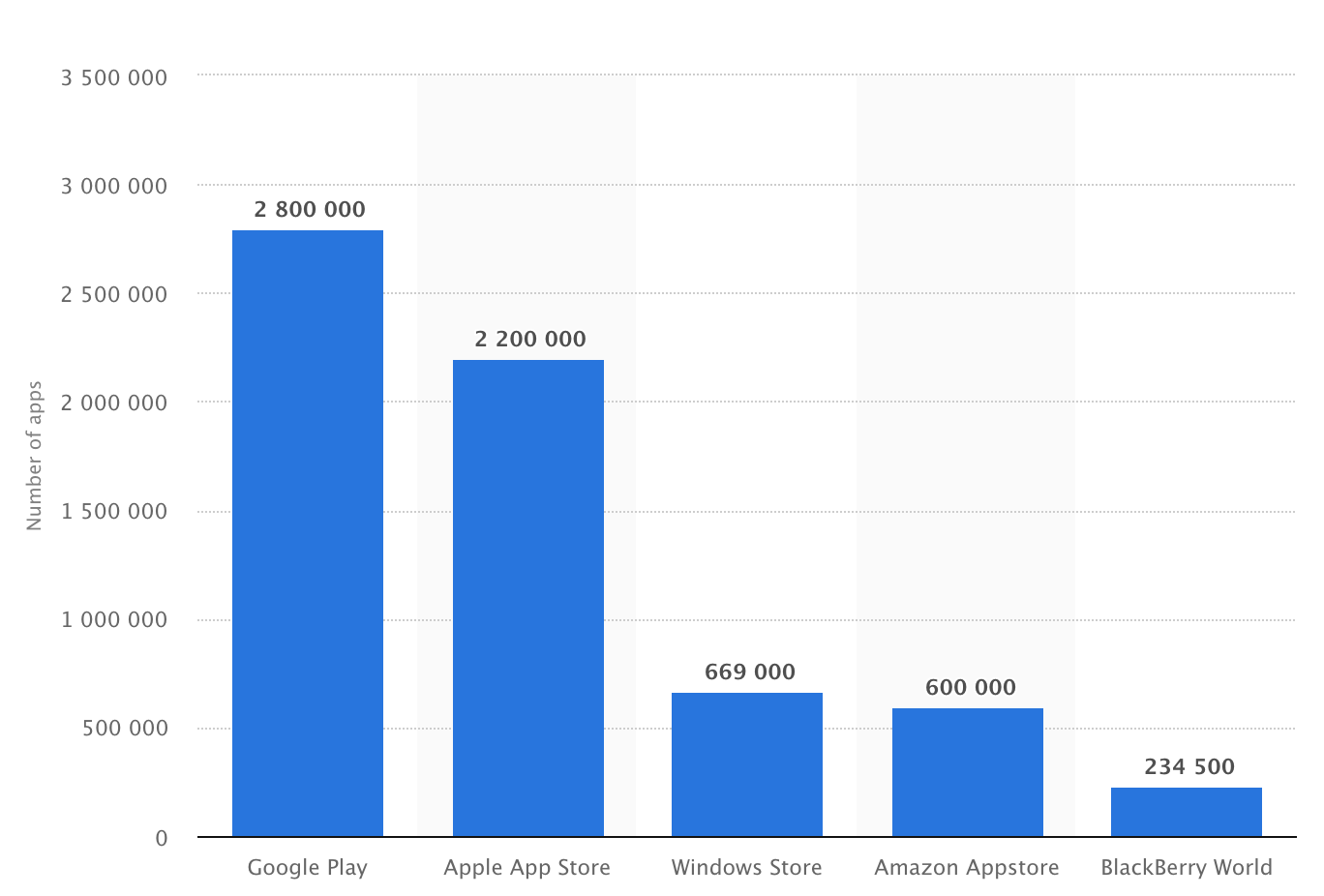6 Mobile App Marketing Strategies
Number of Apps in Top App StoresThis Saturday was my lock-myself-in-clear-all-pending-To-Do day. After burning my retina for almost 10 hours in veg out state in front of the laptop, I decided to treat myself to a good meal, celebrating the clean inbox and a new mile-long To-Do List for the upcoming week.
With barely any energy left, I dragged myself out to the nearest Chicken Rice eatery in my neighbourhood, only to realise, they have an app now! I could have very easily saved some of my calories from burning, enjoyed the plush sofa, decide on the next Netflix binge, and enjoyed a 10% discount on my first order as well, by just ordering my food through the new app.
Before I digress further into my boring schedule, this one is about Mobile App Marketing or Application Marketing.
Let us start with a few basics:
What is Mobile App Marketing?
Google says, “Mobile app marketing is an advertising medium that can complement a brand’s offline experience, drive e-commerce, or simply help connect a brand with its loyal customers“
Close to 40% of the world’s population is projected to use a smartphone by 2018. Needless to say, a mobile marketing strategy is mandatory for all businesses. This can be exercised by either creating a mobile-friendly website or a Mobile App or both.
So how many Apps are there?
There are several App stores. The 5 most popular ones are Google Play, Apple App Store, Windows Store, Amazon Appstore and BlackBerry World.
As of March 2017, Android users were able to choose between 2.8 million apps followed by Apple’s App Store with 2.2 million available apps according to Statista.
Wow, so how many apps do we use in an average?
App Annie says Smartphone owners are using 9 apps per day, 30 per month. iPhone users tend to use slightly more apps than Android users, but Android users used over 30 percent more games.
Interestingly though, over 80 percent of app usage takes place in apps that are outside of the top app in that country — meaning although apps like WhatsApp and Facebook dominate user attention, there’s still enough “user time” to target.
In this sea of millions of Apps, how do you grab market share and/or gradually move to be the top App?
Let me tell you, it takes time but is doable. Here is our Top 6 Mobile App Marketing Strategies.
1. Make your app discoverable
When using their smartphones, users find out about apps in all kinds of instances — while watching a YouTube video, when they’re engaged in an app, searching for another specific app, or even surfing a mobile website.
In fact, 40% of smartphone users still browse for apps in app stores. However, these days at least 1 in 4 apps are discovered through search engines.
Users not only turn to search for finding new apps but also download them from search ads. Search ads raise app visibility and drive app downloads. For example, if a person is searching for a nearby mall, will not search it in App Store but will search it online on social media.
Be Safe, make your app discoverable everywhere, including search
2. Keep your apps sticky
24% of Users abandon an App after one use. The stickiness of apps is measured as a sum of “power users” i.e. % of people who launch an app 10+ times per month+ “loyal users” i.e. % of people who return to an app within 3 months of their first session.
Although achieving sufficient mobile app engagement and user retention rates is a challenge, a few basics should get you started:
a) App Features — publish new features and personalized content to make your app refreshing for the users. Although in most cases it’s your users prerogative to enable push notifications, it sure does increases user retention anywhere from a 56% to a 180%. To begin with, do activate the feature from your end.
c) Consumer Behaviour — Know your power users, track them on how they use your app. Incentivise and strategize to drive engagement and retention.
3. Be original and/or improvise
An app performs when the idea is original and when it meets the need of your target audience. While the basics like having an appealing design, logo, description and brand name will help the app perform better, being original definitely adds to the spunk.
But how many originals are invented these days? One can be a late entrant to an already crowded genre of mobile apps, but still create a niche for itself by knowing its competitors, market landscape and target user preferences.
How to find your competitors or the best app in your chosen category?
By simply searching within the app stores, or by using one of the ASO tools available such as App Annie, SensorTower, or AppMind.
Know what advanced features or improvements are being requested by the target audience for your competitor apps. Incorporate improved versions of these to stand out.
4. Unique and/or long tail keywords
Keywords are an important factor for any online ranking. When your target audience is searching for an app, it is the usage of the right search keyword that enables your app to drive more traffic.
Imagine that you have just launched your new app and are really excited about it. Your app is quite different than others in the same space and offers a great experience.
There is only one problem — it cannot be found in the App Store.
In such a situation, Keywords can be a game changer. The ASO tools as mentioned earlier are a good place to start looking for the right set of keywords. A low-cost approach will be focusing on relevant but long tail keywords.
Bear in mind the relevance and positioning of the keywords before bidding.
a) Relevance: It is very important to choose a keyword that describes the app’s main functional area. Don’t miss exploring the relevant long tail keywords, which are more human in nature.
b) Position: Know your competitor’s keywords and it’s placements. Consider placing yours in a less competitive category to improve your chances of standing out.
5. Localize
You may have an app that’s popular in the US, but that doesn’t mean it won’t need adapting for different English-speaking markets. When localizing for the UK, Singapore, India, Russia or any other region, be sure to factor in your ASO strategy.
Realistically, you won’t be able to roll out a full international mobile app localization project at once, so select the countries that show higher demand for your product or service.
China, for example, is a potential goldmine for apps that get it right. It’s the biggest app market in the world, with revenue set to reach close to $50 billion by 2020. But, it isn’t an easy market to enter. Ideally, you’ll localize your mobile app for both Android and iOS platforms, to expand your reach. With the absence of Google Play in China, get ready to deal with thousands of local Android app stores!
Target an iOS app localization if you want a smoother entry, as the App Store’s rules are the same around the world.
6. Update the app frequently and monitor the performance:
It is important to interact with the users often to keep them engaged. Interactions can be by responding to customer reviews, updating the app to suit the new phone launch (e.g customizing your app’s display based on the latest iPhoneX specs), removing bugs and adding more features. Once a new version or update is launched, be sure to track and monitor performance
Since mobile searches have surpassed desktop searches, it is now imperative for marketers to have a mobile strategy. Supplement your brand with an App, well marketed, user-friendly and interactive and you can grab a larger share of the pie. Not only brands but these days even the best app developers are willing to put in the required time, energy and money to make their app successful, by proper marketing.
Post a Comment
You must be logged in to post a comment.






